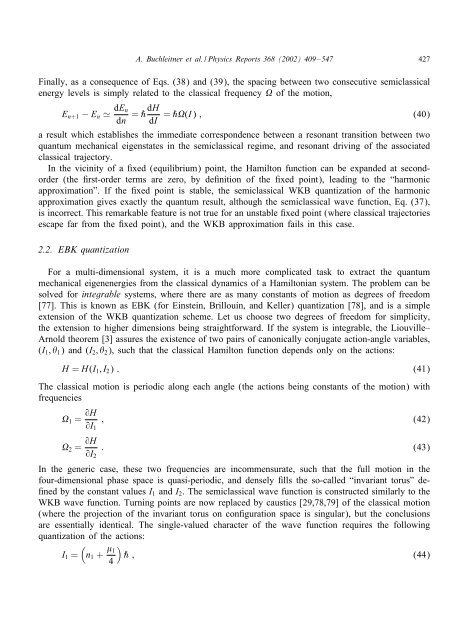Non-dispersive wave packets in periodically driven quantum systems
Non-dispersive wave packets in periodically driven quantum systems
Non-dispersive wave packets in periodically driven quantum systems
Create successful ePaper yourself
Turn your PDF publications into a flip-book with our unique Google optimized e-Paper software.
A. Buchleitner et al. / Physics Reports 368 (2002) 409–547 427<br />
F<strong>in</strong>ally, as a consequence of Eqs. (38) and (39), the spac<strong>in</strong>g between two consecutive semiclassical<br />
energy levels is simply related to the classical frequency of the motion,<br />
En+1 − En dEn<br />
dn<br />
= ˝dH<br />
dI<br />
= ˝ (I) ; (40)<br />
a result which establishes the immediate correspondence between a resonant transition between two<br />
<strong>quantum</strong> mechanical eigenstates <strong>in</strong> the semiclassical regime, and resonant driv<strong>in</strong>g of the associated<br />
classical trajectory.<br />
In the vic<strong>in</strong>ity of a xed (equilibrium) po<strong>in</strong>t, the Hamilton function can be expanded at secondorder<br />
(the rst-order terms are zero, by de nition of the xed po<strong>in</strong>t), lead<strong>in</strong>g to the “harmonic<br />
approximation”. If the xed po<strong>in</strong>t is stable, the semiclassical WKB quantization of the harmonic<br />
approximation gives exactly the <strong>quantum</strong> result, although the semiclassical <strong>wave</strong> function, Eq. (37),<br />
is <strong>in</strong>correct. This remarkable feature is not true for an unstable xed po<strong>in</strong>t (where classical trajectories<br />
escape far from the xed po<strong>in</strong>t), and the WKB approximation fails <strong>in</strong> this case.<br />
2.2. EBK quantization<br />
For a multi-dimensional system, it is a much more complicated task to extract the <strong>quantum</strong><br />
mechanical eigenenergies from the classical dynamics of a Hamiltonian system. The problem can be<br />
solved for <strong>in</strong>tegrable <strong>systems</strong>, where there are as many constants of motion as degrees of freedom<br />
[77]. This is known as EBK (for E<strong>in</strong>ste<strong>in</strong>, Brillou<strong>in</strong>, and Keller) quantization [78], and is a simple<br />
extension of the WKB quantization scheme. Let us choose two degrees of freedom for simplicity,<br />
the extension to higher dimensions be<strong>in</strong>g straightforward. If the system is <strong>in</strong>tegrable, the Liouville–<br />
Arnold theorem [3] assures the existence of two pairs of canonically conjugate action-angle variables,<br />
(I1; 1) and (I2; 2), such that the classical Hamilton function depends only on the actions:<br />
H = H(I1;I2) : (41)<br />
The classical motion is periodic along each angle (the actions be<strong>in</strong>g constants of the motion) with<br />
frequencies<br />
1 = 9H<br />
; (42)<br />
9I1<br />
2 = 9H<br />
: (43)<br />
9I2<br />
In the generic case, these two frequencies are <strong>in</strong>commensurate, such that the full motion <strong>in</strong> the<br />
four-dimensional phase space is quasi-periodic, and densely lls the so-called “<strong>in</strong>variant torus” dened<br />
by the constant values I1 and I2. The semiclassical <strong>wave</strong> function is constructed similarly to the<br />
WKB <strong>wave</strong> function. Turn<strong>in</strong>g po<strong>in</strong>ts are now replaced by caustics [29,78,79] of the classical motion<br />
(where the projection of the <strong>in</strong>variant torus on con guration space is s<strong>in</strong>gular), but the conclusions<br />
are essentially identical. The s<strong>in</strong>gle-valued character of the <strong>wave</strong> function requires the follow<strong>in</strong>g<br />
quantization of the actions:<br />
<br />
I1 = ˝ ; (44)<br />
n1 + 1<br />
4











